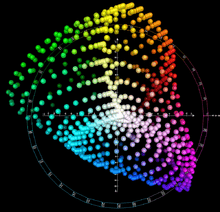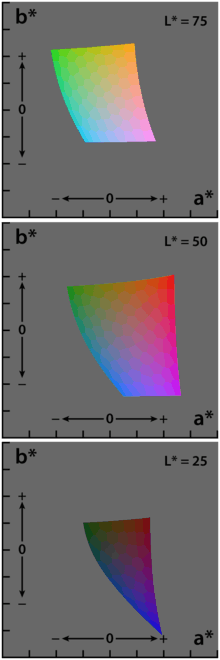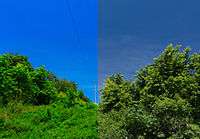CIELAB color space
The CIELAB color space (also known as CIE L*a*b* or sometimes abbreviated as simply "Lab" color space) is a color space defined by the International Commission on Illumination (CIE) in 1976. It expresses color as three values: L* for the lightness from black (0) to white (100), a* from green (−) to red (+), and b* from blue (−) to yellow (+). CIELAB was designed so that the same amount of numerical change in these values corresponds to roughly the same amount of visually perceived change.



With respect to a given white point, the CIELAB model is device-independent—it defines colors independently of how they are created or displayed. The CIELAB color space is typically used when graphics for print have to be converted from RGB to CMYK, as the CIELAB gamut includes both the gamuts of the RGB and CMYK color models.
Because three parameters are measured, the space itself is a three-dimensional real number space, which allows for infinitely many possible colors. In practice, the space is usually mapped onto a three-dimensional integer space for digital representation, and thus the L*, a*, and b* values are usually absolute, with a pre-defined range. The lightness value, L*, represents the darkest black at L* = 0, and the brightest white at L* = 100. The color channels, a* and b*, represent true neutral gray values at a* = 0 and b* = 0. The a* axis represents the green–red component, with green in the negative direction and red in the positive direction. The b* axis represents the blue–yellow component, with blue in the negative direction and yellow in the positive direction. The scaling and limits of the a* and b* axes will depend on the specific implementation, as described below, but they often run in the range of ±100 or −128 to +127 (signed 8-bit integer).
The CIELAB color space was derived from the prior "master" CIE 1931 XYZ color space, which predicts which spectral power distributions will be perceived as the same color (see metamerism), but is not particularly perceptually uniform.[1] Strongly influenced by the Munsell color system, the intention behind CIELAB was to create a space that can be computed via simple formulas from the CIEXYZ space but is more perceptually uniform than CIEXYZ.[2] When storing color values using limited precision, using a perceptually uniform color space can improve the reproduction of tones.
CIELAB colors are defined relative to the white point of the CIEXYZ space from which they were converted; thus CIELAB values do not define absolute colors unless the white point is also specified. Often, in practice, the white point is assumed to follow a standard and is not explicitly stated (e.g., for "absolute colorimetric" rendering intent, the International Color Consortium L*a*b* values are relative to CIE standard illuminant D50, while they are relative to the unprinted substrate for other rendering intents).[3]
The lightness correlate in CIELAB is calculated using the cube root of the relative luminance.
Advantages

Unlike the RGB and CMYK color models, Lab color is designed to approximate human vision. It aspires to perceptual uniformity, and its L component closely matches human perception of lightness (although it does not take the Helmholtz–Kohlrausch effect into account). Thus, it can be used to make accurate color balance corrections by modifying output curves in the a and b components, or to adjust the lightness contrast using the L component. In RGB or CMYK spaces, which model the output of physical devices rather than human visual perception, these transformations can be done only with the help of appropriate blend modes in the editing application.
Because the Lab space is larger than the gamut of computer displays and printers and because the visual stepwidths are relatively indifferent to the color area, a bitmap image represented as Lab requires more data per pixel to obtain the same precision as an RGB or CMYK bitmap. In the 1990s, when computer hardware and software were limited to storing and manipulating mostly 8-bit/channel bitmaps, converting an RGB image to Lab and back was a very lossy operation. With 16-bit/channel and floating-point support now common, the loss due to quantization is negligible.
CIELAB is copyright- and licence-free. As it is fully defined mathematically, the CIELAB model is public domain. It is in all respects freely usable and integrable (as are systematic Lab / HLC color value tables).
A large portion of the Lab coordinate space cannot be generated by spectral distributions. These Lab values therefore fall outside of human vision and are not truly "colors".
Differentiation
Some specific uses of the abbreviation in software, literature etc.
- In Adobe Photoshop, image editing using "Lab mode" is CIELAB D50.[4][5]
- In Affinity Photo, Lab editing is achieved by changing the document's Colour Format to "Lab (16 bit)"
- In ICC profiles, the "Lab color space" used as a profile connection space is CIELAB D50.[3]
- In TIFF files, the CIELAB color space may be used.[6]
- In PDF documents, the "Lab color space" is CIELAB.[7][8]
- In Digital Color Meter on macOS, it is described as "L*a*b*"
- In RawTherapee, the "Lab color space" is CIELAB.[9]
CIELAB
CIE L*a*b* (CIELAB) is a color space specified by the International Commission on Illumination (French Commission internationale de l'éclairage, hence its CIE initialism). It describes all the colors visible to the human eye and was created to serve as a device-independent model to be used as a reference.
The three coordinates of CIELAB represent the lightness of the color (L* = 0 yields black and L* = 100 indicates diffuse white; specular white may be higher), its position between red/magenta and green (a*, negative values indicate green while positive values indicate magenta) and its position between yellow and blue (b*, negative values indicate blue and positive values indicate yellow). The asterisk (*) after L, a and b are pronounced star and are part of the full name, since they represent L*, a* and b*, to distinguish them from Hunter's L, a, and b, described below.
Since the L*a*b* model is a three-dimensional model, it can be represented properly only in a three-dimensional space.[10] Two-dimensional depictions include chromaticity diagrams: sections of the color solid with a fixed lightness. It is crucial to realize that the visual representations of the full gamut of colors in this model are never accurate; they are there just to help in understanding the concept.
Because the red-green and yellow-blue opponent channels are computed as differences of lightness transformations of (putative) cone responses, CIELAB is a chromatic value color space.
A related color space, the CIE 1976 (L*, u*, v*) color space (a.k.a. CIELUV), preserves the same L* as L*a*b* but has a different representation of the chromaticity components. CIELAB and CIELUV can also be expressed in cylindrical form (CIELCH[11] and CIELCHuv, respectively), with the chromaticity components replaced by correlates of chroma and hue.
Since the work on CIELAB and CIELUV, the CIE has been incorporating an increasing number of color appearance phenomena into their models, to better model color vision. These color appearance models, of which CIELAB is a simple example,[12] culminated with CIECAM02.
Perceptual differences
The nonlinear relations for L*, a*, and b* are intended to mimic the nonlinear response of the eye. Furthermore, uniform changes of components in the L*a*b* color space aim to correspond to uniform changes in perceived color, so the relative perceptual differences between any two colors in L*a*b* can be approximated by treating each color as a point in a three-dimensional space (with three components: L*, a*, b*) and taking the Euclidean distance between them.[13]
RGB and CMYK conversions
There are no formulas for conversion between RGB or CMYK values and L*a*b*, because the RGB and CMYK color models are device-dependent. The RGB or CMYK values first must be transformed to a specific absolute color space, such as sRGB or Adobe RGB. This adjustment will be device-dependent, but the resulting data from the transform will be device-independent, allowing data to be transformed to the CIE 1931 color space and then transformed into L*a*b*.
Range of coordinates
As mentioned previously, the L* coordinate ranges from 0 to 100. The possible range of a* and b* coordinates is independent of the color space that one is converting from, since the conversion below uses X and Z, which come from RGB.
CIELAB–CIEXYZ conversions
Forward transformation
where, being t=Y/Yn:
Here, Xn, Yn and Zn are the CIE XYZ tristimulus values of the reference white point (the subscript n suggests "normalized").
Under Illuminant D65 with normalization Y = 100, the values are
Values for illuminant D50 are
The division of the domain of the f function into two parts was done to prevent an infinite slope at t = 0. The function f was assumed to be linear below some t = t0, and was assumed to match the t1/3 part of the function at t0 in both value and slope. In other words:
The intercept f(0) = c was chosen so that L* would be 0 for Y = 0: c = 16/116 = 4/29. The above two equations can be solved for m and t0:
where δ = 6/29.[14]
Reverse transformation
The reverse transformation is most easily expressed using the inverse of the function f above:
where
and where δ = 6/29.
Hunter Lab
The Hunter Lab color space, defined in 1948[15][16] by Richard S. Hunter, is another color space sometimes referred to as "Lab". Like CIELAB, it was also designed to be computed via simple formulas from the CIEXYZ space, but to be more perceptually uniform than CIEXYZ. Hunter named his coordinates L, a, and b; the CIELAB space, defined years later in 1976, named its coordinates L*, a*, and b* to distinguish them from Hunter's coordinates.
L is a correlate of lightness, and is computed from the Y tristimulus value using Priest's approximation to Munsell value:
where Yn is the Y tristimulus value of a specified white object. For surface-color applications, the specified white object is usually (though not always) a hypothetical material with unit reflectance that follows Lambert's law. The resulting L will be scaled between 0 (black) and 100 (white); roughly ten times the Munsell value. Note that a medium lightness of 50 is produced by a luminance of 25, since
a and b are termed opponent color axes. a represents, roughly, Redness (positive) versus Greenness (negative). It is computed as:
where Ka is a coefficient that depends upon the illuminant (for D65, Ka is 172.30; see approximate formula below) and Xn is the X tristimulus value of the specified white object.
The other opponent color axis, b, is positive for yellow colors and negative for blue colors. It is computed as:
where Kb is a coefficient that depends upon the illuminant (for D65, Kb is 67.20; see approximate formula below) and Zn is the Z tristimulus value of the specified white object.[17]
Both a and b will be zero for objects that have the same chromaticity coordinates as the specified white objects (i.e., achromatic, grey, objects).
Approximate formulas for Ka and Kb
In the previous version of the Hunter Lab color space, Ka was 175 and Kb was 70. Hunter Associates Lab discovered that better agreement could be obtained with other color difference metrics, such as CIELAB (see above) by allowing these coefficients to depend upon the illuminants. Approximate formulae are:
which result in the original values for Illuminant C, the original illuminant with which the Lab color space was used.
As an Adams chromatic valence space
Adams chromatic valence color spaces are based on two elements: a (relatively) uniform lightness scale, and a (relatively) uniform chromaticity scale.[18] If we take as the uniform lightness scale Priest's approximation to the Munsell Value scale, which would be written in modern notation as:
and, as the uniform chromaticity coordinates:
where ke is a tuning coefficient, we obtain the two chromatic axes:
and
which is identical to the Hunter Lab formulas given above if we select K = Ka/100 and ke = Kb/Ka. Therefore, the Hunter Lab color space is an Adams chromatic valence color space.
Cylindrical representation: CIELCh or CIEHLC
The CIELCh color space is a CIELab cube color space, where instead of Cartesian coordinates a*, b*, the cylindrical coordinates C* (chroma, relative saturation) and h° (hue angle, angle of the hue in the CIELab color wheel) are specified. The CIELab lightness L* remains unchanged.
The conversion of a* and b* to C* and h° is done using the following formulas:
Conversely, given the polar coordinates, conversion to Cartesian coordinates is achieved with:
The LCh color space is not the same as the HSV, HSL or HSB color models, although their values can also be interpreted as a base color, saturation and lightness of a color. The HSL values are a polar coordinate transformation of what is technically defined RGB cube color space. LCh is still perceptually uniform.
Further, H and h are not identical, because HSL space uses as primary colors the three additive primary colors red, green, and blue (H = 0, 120, 240°). Instead, the LCh system uses the four colors red, yellow, green, and blue (h = 0, 90, 180, 270°). Regardless the angle h, C = 0 means the achromatic colors, that is, the gray axis.
The simplified spellings LCh, LCH and HLC are common, but the latter presents a different order. HCL color space (Hue-Chroma-Luminance) on the other hand is a commonly used alternative name for the L*C*h(uv) color space, also known as the cylindrical representation or polar CIELUV. This name is commonly used by information visualization practitioners who want to present data without the bias implicit in using varying saturation.[19][20]
See also
- Color theory
- Opponent color theory
- HSL and HSV
- RGB color model
- CMYK color model
- CIECAM02
- HCL color space
References
- A discussion and proposed improvement, Bruce Lindbloom
- Explanation of this history, Bruce MacEvoy
- International Color Consortium, Specification ICC.1:2004-10 (Profile version 4.2.0.0) Image technology colour management — Architecture, profile format, and data structure, (2006).
- Margulis, Dan (2006). Photoshop Lab Color: The Canyon Conundrum and Other Adventures in the Most Powerful Colorspace. Berkeley, Calif. : London: Peachpit ; Pearson Education. ISBN 0-321-35678-0.
- The Lab Color Mode in Photoshop, Adobe TechNote 310838
- TIFF: Revision 6.0 Archived 2007-07-01 at the Wayback Machine Adobe Developers Association, 1992
- Color Consistency and Adobe Creative Suite Archived 2008-07-25 at the Wayback Machine
- Adobe Acrobat Reader 4.0 User Guide "The color model Acrobat Reader uses is called CIELAB…"
- "Lab Adjustments - RawPedia". rawpedia.rawtherapee.com. Retrieved 2018-05-08.
- 3D representations of the L*a*b* gamut, Bruce Lindbloom.
- CIE-L*C*h Color Scale
- Fairchild, Mark D. (2005). "Color and Image Appearance Models". Color Appearance Models. John Wiley and Sons. p. 340. ISBN 0-470-01216-1.
- Jain, Anil K. (1989). Fundamentals of Digital Image Processing. New Jersey, United States of America: Prentice Hall. pp. 68, 71, 73. ISBN 0-13-336165-9.
- János Schanda (2007). Colorimetry. Wiley-Interscience. p. 61. ISBN 978-0-470-04904-4.
- Hunter, Richard Sewall (July 1948). "Photoelectric Color-Difference Meter". JOSA. 38 (7): 661. (Proceedings of the Winter Meeting of the Optical Society of America)
- Hunter, Richard Sewall (December 1948). "Accuracy, Precision, and Stability of New Photo-electric Color-Difference Meter". JOSA. 38 (12): 1094. (Proceedings of the Thirty-Third Annual Meeting of the Optical Society of America)
- Hunter Labs (1996). "Hunter Lab Color Scale". Insight on Color 8 9 (August 1–15, 1996). Reston, VA, USA: Hunter Associates Laboratories.
- Adams, E.Q. (1942). "X-Z planes in the 1931 I.C.I. system of colorimetry". JOSA. 32 (3): 168–173. doi:10.1364/JOSA.32.000168.
- Zeileis, Achim; Hornik, Kurt; Murrell, Paul (2009). "Escaping RGBland: Selecting Colors for Statistical Graphics" (PDF). Computational Statistics & Data Analysis. 53 (9): 3259–3270. doi:10.1016/j.csda.2008.11.033.
- Stauffer, Reto; Mayr, Georg J.; Dabernig, Markus; Zeileis, Achim (2015). "Somewhere over the Rainbow: How to Make Effective Use of Colors in Meteorological Visualizations" (PDF). Bulletin of the American Meteorological Society. 96 (2): 203–216. doi:10.1175/BAMS-D-13-00155.1. hdl:10419/101098.
External links
- Demonstrative color conversion applet
- CIELAB Color Space by Gernot Hoffmann, includes explanations of L*a*b* conversion formulae, graphical depictions of various gamuts plotted in L*a*b* space, and PostScript code for performing the color transformations.
- Whitepaper on understanding colors by X-rite.